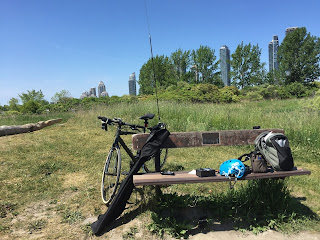 |
| The test setup |

I was out today once again with my portable operations but this time there was no on air time it was time to test and decide. I went out with my
MFJ antenna analyzer, mobile whip antennas and various lengths of counter poise. I wanted to see where my 20m mobile whip antenna was resonant and using the MFJ analyzer was the easiest way of doing this. The counter poise for 20m I started with was 17.5 feet long and the SWR was not showing it was resonant in the CW portion of the band but in the SSB section. So I found I have to lengthen the counter poise to 30 feet to get the SWR to 1.2:1 in the CW portion of 20m. This got me to thinking if the mobile whip was the way to go, I did have these antennas hanging around and I wanted to give them a go to see what results I would get. They are still very useful to me when I operate portable mobile from the car and they preform very well in that situation. I wanted to try the whip antenna as I felt it would be a very small footprint of an antenna but with a counter poise of 30 feet the footprint is larger than I would like. From most of my blog reading about portable trail operation, NPOTA operations and just plan old out in the park for the day operation hands down most of the time the antenna of choice was one of
LNR's par end fed antenna's. I have looked over the antennas at LNR Precisions site and not sure yet which antenna to get, I am leaning toward the EF-20 as it's not as long (33') as say the other models. I'm really not going to use 40m and I figure (but not sure) I can use the Elecraft KX3's tuner to operate 15 and 10M?? Any feedback about this antenna or others would be appreciated.
 A slight change of plans…..
A slight change of plans…..
Mike, the single band version of the End Fed is using a low pass arrangement to match the high impedance of the radiating element to the 50 ohm of the TRX, using the internal tuner to match to 10 and 15 is very inefficient if at all possible. The multiband version however uses a transformer which can handle multiple frequencies. Nothing prevents you from cutting your own lengths of wire to work on other frequencies with that version. You will be surprised about what such a small antenna can do.
Good morning Jan, thanks for stopping by and taking the time to comment. I have sent out a question to the team at LNR to narrow down my choice of antenna. After uploading my post I did read on their site as you just informed me that tuning the mono band antennas is out of the question and can result in damage as well. Once I hear back from then I will for sure be placing my order.
73 and have a great upcoming week.
Mike